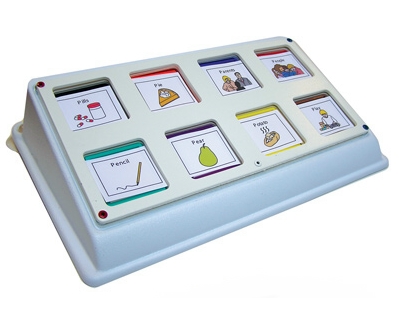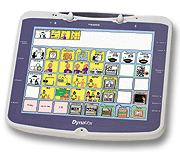Assistive Technology Applications For People With Communication Impairments
Communication impairments are conditions that interfere with a person’s ability to understand or process information or express one's self in an auditory manner. Although some communication impairments are medical conditions that manifest from birth, most are traditionally considered secondary impairments or results of more severe impairments such as Cerebral Palsy or a hearing impairment. Communication impairments can significantly affect the clarity and content of one's speech. They can also be related to a comprehension deficit that results in ineffective verbal communication. For people with communication impairments, there are various AT solutions ranging from low tech to high tech. The ideal device (low to high tech) for each individual to use is often determined by the level of physical or cognitive impairment as well as affordability.Low Tech/ No Tech Communication Options
Low tech and no tech solutions for people with communication impairments are typically items readily available to everyone. An example of a no tech solution is the use of sign language for communication. This entails learning and understanding the language and possessing the ability to form symbols with ones hands, however there is no technology involved. Low tech options can include strategies as simple as using a pen and paper or a dry erase board to communicate. Symbol-based communication that consists of using symbols on a communication board or in a communication book to indicate a desired word or phrase are another low tech means of communicating. The user can indicate the desired symbols through a direct point, an eye gaze, or a series of yes/no questions.
The low tech options cited above are easy to obtain and cost effective. For optimal use of these options, the communication impairment must be the users primary impairment. If the communication impairment is secondary to a cognitive impairment, the individual may not be able to understand written language or abstract symbols representing words or phrases, rendering this options ineffective. There are some disadvantages to using low tech systems. First, these options do not provide an audio output, thus they do not provide the user a "voice". Secondly the lack of audio output makes it difficult for a user to initiate a conversation. Finally, symbols can cause confusion for conversation partners. Some symbols can be abstract and although users are familiar with them, their conversation partners may not be leading to frustrating, slow communication.
Mid Tech Communication Options
Mid tech devices are defined as such because they are slightly more expensive than low tech devices, they run on a power supply, typically batteries, and using them effectively entails some training. These solutions typically consist of some sort of recordable device with a static display and a limited number of options for storing recordings (typically 1 - 30). In a mid tech communication device, each recorded word, phrase, or message is associated with one of the static selection options. When that option is selected, the corresponding message is played. To help the user remember the message associated with each activation option, a symbol, representing each recorded message is typically placed over the corresponding activation button. Each recording can be played by directly pressing the appropriate activation button. Most mid tech communication devices also provide switch scanning options to allow access to people with various levels of physical impairments.
Similar to other device categories, mid tech devices have both benefits and downsides. Benefits of these devices include the provision of a "voice" for the user via an audio output and the relatively inexpensive cost of the device. Due to their limited communication options, mid tech devices are also simple to use, especially for people with cognitive impairments. The presence of an audio output also makes conversation initiation possible. The audio output and ease of use make these devices ideal to convey important basic need messages such as "I need to use the restroom" or "I'm hungry" or "I'm thirsty". One downside of these devices is that the static nature of the displays and necessity to record messages limits speech options for the user. Limited speech options make unplanned conversations difficult. Another issue is that the batteries that power these devices can run out fairly quickly leaving users without a communication option until the batteries can be changed.
High Tech
High tech communication devices, typically referred to as Augmentative and Alternative Communication (AAC) devices, consist of a computer-based, touch screen system with a dynamic display that utilizes a combination of recorded voice and synthesized voice to convey messages for people with communication impairments. To use these types of devices one can either directly type words or phrases to be spoken or activate a symbol that has been programmed to link to a word, phrase, or sentence. Through the keyboard option as well as a dynamic display (the display can change, so if a category is selected such as "food", the display will change to show only options dealing with food), users are only limited in their communication options by what they program into their device. These devices are produced by many manufacturers (Prentke Romich, Assistive Technology, Inc., Words+, Dynavox, etc.) and made in various sizes from PDAs to laptop-sized devices, making them easily portable. To access one of these AAC devices, one can either use direct touch or switch scanning. The number of options and the complexity of scanning makes AAC devices difficult for people with cognitive impairments to use effectively.
Of all of the different types of communication AT mentioned in this section, high tech AAC devices offer the user the most options for communication while also providing the user a "voice" via an audio output. These devices make any conversation possible and also give the user the opportunity to initiate a conversation. High tech AAC devices are also portable and usable across many different environments. The biggest drawback to these devices is their cost, which is often multiple thousands of dollars. The unlimited communication potential can also have a downside, slower conversations and longer pauses while the AAC user navigates the device to find the desired response. These type of devices also require a significant initial training and programming due to their complexity. To provide a user with numerous communication options, someone has to program each option into the device. After the initial setup, programming time becomes more manageable as it is only necessary to update the device. Finally, much like mid tech devices, many high tech devices are battery operated and have the potential to run out, leaving the user without a means of communication, if the user does not pay attention to low battery warnings.
Conclusion
Communication is an essential tool for success in society. Because of this, people with a communication impairment have been at a significant disadvantage to the rest of the population. There are several accommodations to help overcome verbal communication impairments such as written or typed communication, however, communication impairments are often secondary impairments rendering these solutions ineffective. In this section, several device options were discussed that provide access to communication to people with various functional abilities, cognitive abilities, communication needs, and income situations. Devices have progressed toward being more usable and natural sounding with the next step in device development being to create more affordable devices with more human sounding voice synthesis. Based on the advances already made and the importance of communication, considerable communication-related AT advances are expected in the future.
 |
Symbol-based communication boards, computer synthesized voices, and computer-based dynamic displays are some of the alternatives a person with a communication impairment can use to express himself or herself. |
 |
The Cheap Talk 8 is an example of a mid tech AT option for communication. Each of the eight squares acts as a button that when pressed, plays a recorded message. On this particular Cheap Talk, symbols have been placed over each square to represent that square's recorded message. |
 |
The Dynavox is an example of a high tech, computer-based, touch screen AAC device. This screen shows symbols that when activated either play a message or change the dynamic display to display other symbols with messages to expand conversation options |